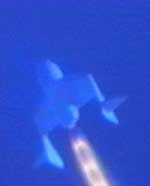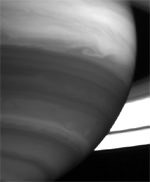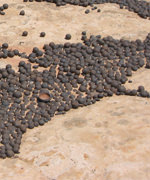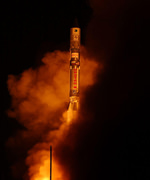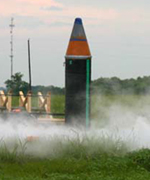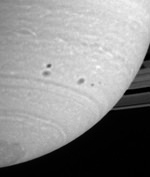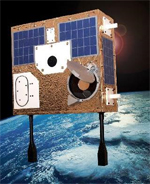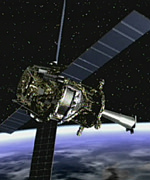
Image credit: NASA
Gravity Probe B ? a NASA mission to test two predictions of Albert Einstein’s Theory of General Relativity ? is about half way through the initialization and orbit checkout phase of the mission. The mission’s operations team has successfully transmitted over 5,000 commands to the spacecraft, which remains healthy on orbit. Launched from Vandenberg Air Force Base, Calif., Gravity Probe B is managed by the Marshall Center.
On its 52nd day in orbit, the spacecraft continues to be in good health, with all subsystems performing very well. The spacecraft’s orbit, which will remain in full sunlight through August, is stable and meets our requirements for transition into the science phase of the mission. All four gyros are digitally suspended and have passed several very slow-speed calibration tests. Furthermore, the science telescope is locked onto the guide star, IM Pegasi, and we have verified that it is locked onto the correct star
Over the past two weeks, through a combination of software modifications, revised procedures, and commands sent directly to the spacecraft, considerable progress has been made in adjusting the Attitude and Translation Control system (ATC) to properly maintain the spacecraft’s attitude (pitch, yaw, and roll) in orbit. The ATC system accomplishes this important job by controlling the flow of helium gas, continually venting from the Dewar, through the spacecraft’s micro thrusters. This system is critical to the success of the mission because it maintains the required roll rate of the spacecraft, it keeps the spacecraft and science telescope pointed at the guide star, and it keeps the spacecraft in a drag-free orbit. Thus, the team is particularly gratified to now have the ATC functioning reliably, with the science telescope locked onto IM Pegasi.
The “Pegasi” part of the guide star’s name indicates that is located in the constellation Pegasus; the “IM” prefix (as opposed to a Greek letter prefix) indicates that it is a variable star; in fact, it is actually part of a binary star system (one of a pair of stars that closely orbit each other). On a star map, its location coordinates are:
Right Ascension–22 hours 53 minutes 2.27 seconds
Declination–16 degrees 50 minutes 28.3 seconds
IM Peg is about 300 light years from Earth, and its maximum magnitude is 5.85–barely visible to the naked eye. In the Northern Hemisphere, you can view the constellation Pegasus in the evening sky from late August (rises on the Eastern horizon) to early January (sets on the Western horizon).
The process of locking the science telescope onto IM Pegasi started with star trackers on either side of the spacecraft locating familiar patterns of stars. Feedback from the star trackers was used to adjust the spacecraft’s attitude so that it was pointing to within a few degrees of the guide star. The telescope’s shutter was then opened, and a series of increasingly accurate “dwell scans” was performed to home in on the star. Since the spacecraft is rotating along the axis of the telescope, imbalance in the rotation axis can cause the guide star to move in and out of the telescope’s field of view. Feedback from the telescope was sent to the ATC system, which adjusted the spacecraft’s attitude until the guide star remained focused in the telescope throughout multiple spacecraft roll cycles. The ATC was then commanded to “lock” onto the guide star.
Finally, to verify that the telescope was locked onto the correct guide star, the micro thrusters were used to point the spacecraft/telescope at a known neighboring star, HD 216635 (SAO 108242), 1.0047 degrees above IM Pegasi. When the telescope was pointed at this location, the neighboring star appeared with anticipated brightness, and there were no other stars in the immediate vicinity. Thus, the sighting of the star, HD 216635, confirmed the correct relationship between the locations of the two stars, ensuring that the telescope is indeed locked onto the correct guide star. In addition, the telescope has also seen the star HR Peg (HR 8714), a brighter and redder star, located less than half a degree to the left of IM Pegasi.
This past week the team continued performing calibration tests of all gyros, spinning at less than 1 Hz (60 rpm). In addition, the team successfully tested a back-up drag-free mode of the spacecraft with three of the gyros for an entire orbit, and, more significantly, the team completed its first successful test of the primary drag-free mode since re-configuring the micro thrusters, using gyro #3.
In primary drag-free mode, the Gyro Suspension System (GSS) is turned off on one of the gyros, so that no forces are applied to it. The ATC uses feedback from the position of this gyro in its housing to “steer” the spacecraft, keeping the gyro centered. Back-up drag-free mode is similar, but in this case the GSS applies very light forces on the gyro to keep it suspended and centered in its housing. The ATC uses feedback from the GSS to “steer” the spacecraft so that the GSS forces are nullified or canceled, thereby keeping the gyro centered. Applying forces with the GSS to suspend the drag-free gyro adds a very small, but acceptable, amount of noise to the gyro signal, and thus, either primary or back-up drag-free mode can be employed during the science experiment. Upcoming milestones include maintaining the spacecraft in a drag-free orbit, and beginning gyro calibration tests at spin rates of up to 5 Hz (300 rpm).
NASA’s Marshall Space Flight Center in Huntsville, Ala., manages the Gravity Probe B program for NASA’s Office of Space Science. Stanford University in Stanford, Calif., developed and built the science experiment hardware and operates the science mission for NASA. Lockheed Martin of Palo Alto, Calif., developed and built the GP-B spacecraft.
Original Source: NASA News Release

